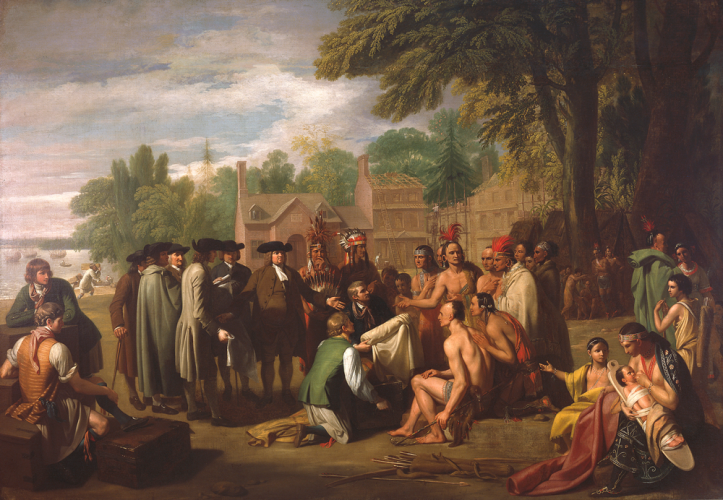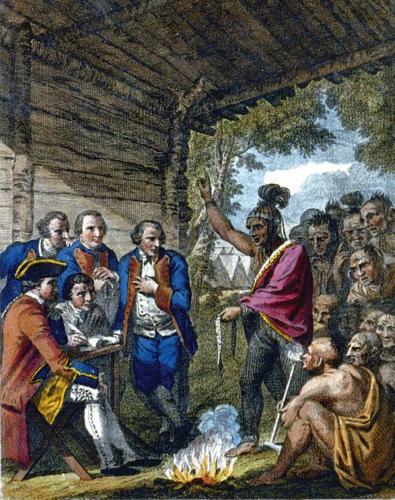Treaties matter, not only to American Indians, but to everyone who lives in the United States. The United States acquired much of its land through treaties with Indian tribes. These negotiated, bilateral agreements are, therefore, fundamental to understanding how the United States was created, and how its citizens obtained the land and natural resources they enjoy today.
Treaties rest at the heart of both Native history and contemporary tribal life and identity. Approximately 368 treaties were negotiated and signed by U.S. commissioners and tribal leaders (and subsequently approved by the U.S. Senate) from 1777 to 1868. They enshrine promises our government made to Indian Nations. They recognize Indian tribes as nations – a fact that distinguishes tribal citizens from other Americans and supports contemporary Native assertions of tribal sovereignty and self-determination.
Far from being dusty documents of dubious relevance, treaties are legally binding and still in effect. Although repeatedly recognized by the courts as sources of rights for Indian people and their Native Nations, treaties also carry the weight of a troubled history of broken promises and test the strength of our nation’s commitment to honesty, good faith and the rule of law.
Treaties made by the United States with Indian Nations inscribe solemn vows that cannot lightly be broken or ignored, a verity that Supreme Court Justice Hugo Black recognized in 1960 when he declared, “Great nations, like great men, should keep their word.”
Despite the moral, legal, historical and contemporary significance of Indian treaties, most Americans know little about them. That fact unsettled the late senator Daniel K. Inouye (D. – Hawaii), the longtime chairman, vice-chairman and member of the Senate Committee on Indian Affairs, who lamented: “I would venture to guess that to the extent they have ever had occasion to think about them, most Americans think of treaties as ancient relics of the past that have long since been forgotten and which certainly have no relevance to modern society.”
Said Inouye: “Too few Americans know that the Indian nations ceded millions of acres of lands to the United States, or that…the promises and commitments made by the United States were typically made in perpetuity. History has recorded, however, that our great nation did not keep its word to the Indian nations, and our preeminent challenge today…is to assure the integrity of our treaty commitments and to bring an end to the era of broken promises.”
The National Museum of the American Indian was established by Congress to rectify our nation’s historical amnesia about the role of Native Nations in the making of modern America. Treaties are at the core of the relationship between Indian Peoples and the United States. I have heard many times, from Natives and non-Natives alike, that the Museum must tell the “real story” of the history between the U.S. and the Indian tribes. Telling that story is undoubtedly a part of our responsibility as an educational institution dedicated to increasing and diffusing knowledge about Native history and culture. As we celebrate the 25th anniversary of the founding of our Museum and the 10th anniversary of the opening of our
flagship Museum on the National Mall in Washington, D.C., it is most fitting that we present Nation to Nation, an exhibition telling the story of treaties between the United States and American Indian Nations.
The exhibit will be marked by a companion book, Nation to Nation: Treaties Between the United States and American Indian Nations. The contributors, a distinguished group of Native and non-Native historians, legal scholars and tribal activists, have tapped a vast array of sources, including tribal oral traditions, interviews, historical documents, illustrations, newspaper articles and Native material culture, to recount the evolution of U.S.–Indian treaty making from the 17th century to the present. Their work focused on many different aspects of the treaty story, yet the book is unified by a consistent effort to interpret the history of U.S.–Indian treaty making from the perspective of Native people. This approach, which animates recent scholarship in American Indian history, is consistent with one of the principal canons of American law concerning treaties – that treaties must be interpreted as the Native signers understood them.
From a Native perspective, the story began with American acceptance of tribal self-government and nation-to-nation diplomacy through treaty making. That promising start quickly morphed into disaster through broken and coercive treaties that promoted Indian removal and tribal land loss, as well as government policies that dismantled tribes as political institutions, obliterated tribal land ownership and fostered the forced assimilation of Native people into white culture.
Happily, the story does not end there. For Native people never gave up on their treaties or the tribal sovereignty that treaties recognized. Beginning in the 1960s, Native activists invoked America’s growing commitment to social justice to restore broken treaties, to demand congressional legislation – or modern treaty amendments – that repaired the damages that had been inflicted on tribal communities by U.S. Indian policies, and to rejuvenate tribal governments long subjugated by heavy-handed federal agents. Today, the reassertion of treaty rights and tribal self-determination is evident in renewed tribal political, economic and cultural strength, as well as in reinvigorated nation-to-nation relations with the United States.
The fundamental tenets of early treaty making – the recognition of tribal governments and Indian consent – are alive and well…at least for the moment. The future is untold, and ultimately the gains of Native Nations in modern times are set in fragile beads rather than carved in stone. Yet there is optimism in Indian Country that Americans will better understand their shared history with Indian Nations and that, as a result, they will join Native people in celebrating and upholding the rights enshrined in treaties.



